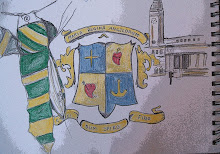One of the websites I looked at, InstantShift.com had a list of the top 21 more used fonts by professional designers. Out of the top 21, 14 of those were sans serifs and the top 4 were sans serifs too. Perhaps this shows the modernity and also readability of the sans serifs as opposed to the serifs typefaces, which are more elaborate and maybe regarded as less legible than sans serifs. It was ‘Helevetica’ that was placed at the top of this list of fonts.
Another piece of info graphics I found was based on the use of various typefaces and was set out as a periodic table, obviously with the chemical symbols being replaced by the typefaces. I found this a very interesting and clever piece of graphics and way of looking at use and popularity of different typefaces that exist now. It distinguished whether the font was a serif or sans serif and also who designed it and the year that it was designed. The number next to it was it’s ranking in the table of fonts. Again, ‘Helevetica’ came out on top. As well as other typefaces reappearing again and again, like ‘Futura’, ‘Gill Sans’ and ‘Univers’, all of which are sans serifs.

A piece of work by a graphic design student, Julian Hansen, has also captured my eye - “So you need a typeface”. It’s an alternative way of helping you choose a specific font for a particular piece of work you are going to start work on. He has been inspired by The Best 100 Fonts by FontShop and has based this piece on the top 50 in particular. Julian Hansen looked at a lot of different ways and contexts in which a font might be used and he has even mentioned info graphics. ‘Univers’ has been highlighted as an example of an infographic when wanting to create something very condensed. He has added humour into his work as well, which makes this piece even more eye catching because you want to follow on what he has written for each example. Other examples for infographics that he has included are ‘Letter Gothic’, ‘OCR’ and ‘FF DIN’.

I think, particularly in information graphics, designers want to create work that is going to aid the audience as opposed to create confusion. So a clear and concise typeface that is not only legible but also eye catching and easy to break down and read is vital. It appears from the research shown that sans serifs fit better into this category than serifs do.


No comments:
Post a Comment